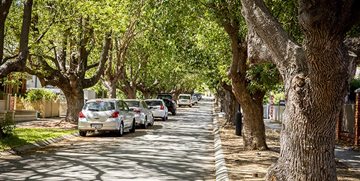The loss of urban green space and native vegetation is a very important issue for Local Government, particularly in urban areas where there is clearing of land for infill and greenfield development.
Reduced canopy cover impacts on public amenity, human health and biodiversity and as trees are often replaced with hard surfaces, this generally leads to increases in average temperatures creating urban heat islands. This often results in increased energy and water use for homes and businesses.
Local Governments have been playing a leading role to address this issue with many developing and implementing urban forest and/or greening strategies, adopting significant tree registers and tree bonds and making amendments to Local Planning Schemes.
To support Local Government efforts to maintain their urban tree canopy, it is vital that State Government provides the necessary statutory guidance and planning policies and WALGA will continue to advocate strongly for these changes.
Resources
Better Urban Forest Planning Guide
In November 2018, WALGA along with the Western Australian Planning Commission and the Department of Planning, Lands and Heritage released the Better Urban Forest Planning Guide. The Guide will assist Councils, developers and government agencies in their planning and policies around urban greening, tree retention and replacement. It includes information on planning, market based and regulatory ‘tools’, case studies that highlight ‘best-practice’ actions and how to access CSIRO’s Urban Monitor data.
WALGA have been actively involved with supporting Local Governments in the preparation of reports, papers and hosting of workshops, including:
- Street Trees Guidance Report (Updated in 2017)
- Urban Tree Canopy Survey of Local Government Results (August 2017)
Tree Retention Issues Papers and Model Local Planning Policy
Trees and other vegetation in urban areas provide significant social, economic, and environmental benefits to the community. The greatest environmental, aesthetic and cooling benefits of trees are provided by large, mature trees which typically have the largest canopy cover. In most urban areas across Western Australia there has been a decline in canopy cover, most of this loss is on private land.
The Local Government Urban Forest Working Group Tree Retention Subcommittee produced an issues paper examining the key challenges for Local Governments in retaining trees on private land and street trees. The issues paper was refined into a series of questions on which legal advice was procured.
- Local Government Approaches to Tree Retention Issues Paper (May 2022)
- Local Government Approaches to Tree Retention Issues Paper for Legal Advice (March 2023)
The removal of a tree is ‘works’ that may require development approval. On this basis it is important the planning framework clarifies the circumstances in which approval is required to remove a tree.
The model local planning policy (LPP) has been developed by WALGA to provide this clarification and establishes consistent policy settings and provisions for regulating trees on private land to reduce uncertainty for decision makers, proponents, and communities.
The model LPP:
- Clarifies that the tree removal (or other tree damaging activity) is works that requires development approval.
- Introduces and defines the term ‘regulated tree’ being a living tree that:
- Is 8m or more high; and/or
- Has an average canopy diameter of at least 6m; and/or
- Has a trunk circumference of at least 1.5m, measured 1.4m above the ground; and
- Is of a species that is not included on State or local area weed register.
- Lists the circumstances where tree damaging activity would be exempt from requiring a development approval (i.e. tree does not meet the definition of regulated tree).
- Promotes and facilitates tree preservation at all stages of the planning and development process, including strategic planning proposals and subdivision applications, as well as development applications.
The model LPP is available for use and each individual Local Government can choose to adopt the LPP in accordance with the procedures set out in the Planning and Development (Local Planning Scheme) Regulations 2015, which requires community consultation and consideration by Council.
- Tree Retention Model Local Planning Policy (Word Doc) (March 2024)
- Tree Retention Model Local Planning Policy (PDF) (March 2024)
Data
There are a number of approaches Local Governments take in measuring urban canopy. The Department of Planning, Lands and Heritage provides open source urban canopy data through Urban Forest mapping and via the Urban Tree Canopy Dashboard.
Further resources on urban forests:
- How to Create an Urban Forest (202020 Vision)
- Urban Forest Projects (202020 Vision)
Local Government Urban Forest Working Group
In early 2019 WALGA established the Local Government Urban Forest Working Group and is currently represented by 34 Local Governments from across the state. The purpose of the Working Group is to build the capacity of Local Government, identifying gaps and developing practical planning outcomes and tools. The Working Group operates as a community of practice for members to share their experiences, take collective action and responsibility for progressing agreed priority issues.


